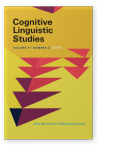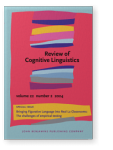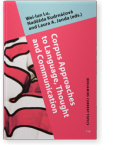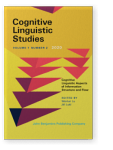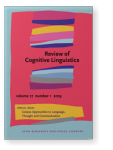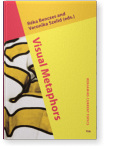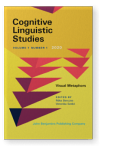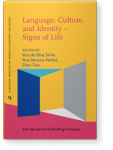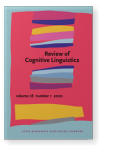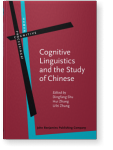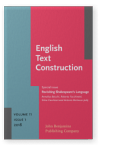Wei-lun Lu
List of John Benjamins publications for which Wei-lun Lu plays a role.
Journals
ISSN 2214-3157 | E-ISSN 2214-3165
ISSN 1877-9751 | E-ISSN 1877-976X
Corpus Approaches to Language, Thought and Communication
Edited by Wei-lun Lu, Naděžda Kudrnáčová and Laura A. Janda
[Benjamins Current Topics, 119] 2021. v, 157 pp.
Subjects Cognition and language | Cognitive linguistics | Corpus linguistics | Theoretical linguistics
Cognitive Linguistic Aspects of Information Structure and Flow
Edited by Wei-lun Lu and Jirí Lukl
Special issue of Cognitive Linguistic Studies 7:2 (2020) v, 165 pp.
Subjects Cognition and language | Cognitive linguistics | Cognitive psychology | Neurolinguistics | Psycholinguistics
Corpus Approaches to Language, Thought and Communication
Edited by Wei-lun Lu, Naděžda Kudrnáčová and Laura A. Janda
Special issue of Review of Cognitive Linguistics 17:1 (2019) vi, 301 pp.
Subjects Cognition and language | Cognitive linguistics
Persuasion in Public Discourse: Cognitive and functional perspectives
Edited by Jana Pelclová and Wei-lun Lu
[Discourse Approaches to Politics, Society and Culture, 79] 2018. vi, 334 pp.
Subjects Communication Studies | Discourse studies | Pragmatics
2022 Rendering, generalization and variation: On the use of multiple parallel texts as a comparative method in cognitive poetics Visual Metaphors, Benczes, Réka and Veronika Szelid (eds.), pp. 209–230 | Chapter
The chapter presents a case study of how the use of multiple parallel texts may be employed as a useful research method in cognitive poetics, using the English version of Alice’s Adventures in Wonderland and Through the Looking-Glass and its four published Czech versions as the samples. In the… read more
2022 Viewpoint and metaphor in culture: A Cognitive Linguistic analysis on a selection of Chinese eulogistic idioms used in Taiwan Visual Metaphors, Benczes, Réka and Veronika Szelid (eds.), pp. 263–282 | Chapter
The chapter presents an in-depth analysis of the language of death in Chinese and discusses the relation between language and occupation as a social factor in analyzing the language of death. In this chapter, I address in what specific ways Cognitive Linguistics may serve as a useful analytical… read more
2021 The near-synonymy of classifiers and construal operation: A corpus-based study of 棵 kē and 株 zhū in Chinese Corpus Approaches to Language, Thought and Communication, Lu, Wei-lun, Naděžda Kudrnáčová and Laura A. Janda (eds.), pp. 115–132 | Chapter
This paper investigates the near-synonymy of classifiers, using Chinese kē and zhū as illustration. We find that in [quantifier] – [classifier] – [noun], the two classifiers have overlapping semantic prototypes due to their similar behavioral profiles. However, despite a shared functional core,… read more
2021 Deep dives into big data: Best practices for synthesis of quantitative and qualitative analysis in Cognitive Linguistics Corpus Approaches to Language, Thought and Communication, Lu, Wei-lun, Naděžda Kudrnáčová and Laura A. Janda (eds.), pp. 1–6 | Chapter
2020 Rendering, generalization and variation: On the use of multiple parallel texts as a comparative method in cognitive poetics Visual Metaphors, Benczes, Réka and Veronika Szelid (eds.), pp. 201–221 | Article
The article presents a case study of how the use of multiple parallel texts may be employed as a useful research method in cognitive poetics, using the English version of Alice’s Adventures in Wonderland and Through the Looking-Glass and its four published Czech versions as the samples. In the… read more
2020 Viewpoint and metaphor in culture: A Cognitive Linguistic analysis on a selection of Chinese eulogistic idioms used in Taiwan Visual Metaphors, Benczes, Réka and Veronika Szelid (eds.), pp. 254–274 | Article
The paper presents an in-depth analysis of the language of death in Chinese and discusses the relation between language and occupation as a social factor in analyzing the language of death. In this paper, I address in what specific ways Cognitive Linguistics may serve as a useful analytical… read more
2020 Chapter 7. Cultural “Signs of life” in politics: A case study of eulogistic idioms for Taiwanese politicians Language, Culture and Identity – Signs of Life, Silva Sinha, Vera da, Ana Moreno-Núñez and Zhen Tian (eds.), pp. 141–156 | Chapter
This chapter presents a Cognitive Linguistic analysis of Mandarin eulogistic idioms used for politicians as a sub-genre of political communication. The entire collection of idioms is taken from the online eulogy request system in Taiwan and contains 16 idioms. In the analysis of the idioms, it… read more
2020 Narrative viewpoint and subjective construal across languages: English inversion, associated strategies and their Chinese renditions in multiple parallel texts Cognitive Linguistic Aspects of Information Structure and Flow, Lu, Wei-lun and Jirí Lukl (eds.), pp. 334–356 | Article
The present study explores the viewpointing function of word order inversion and associated stylistic strategies across languages, comparing English-Chinese multiple parallel texts as illustration. In particular, I investigate whether the cognitive strategy of inverting the word order to create a… read more
2020 The flow and structure of information in cognitive linguistics: Discourse, functional and cross-linguistic dimensions Cognitive Linguistic Aspects of Information Structure and Flow, Lu, Wei-lun and Jirí Lukl (eds.), pp. 275–283 | Introduction
2020 Delivering the unconventional across languages: A Cognitive Grammar analysis of nonce words in “Jabberwocky” and its Ukrainian renditions Review of Cognitive Linguistics 18:1, pp. 244–274 | Article
This paper presents an analysis of nonce words that relies on Cognitive Grammar (CG) using the English version of “Jabberwocky” and its two Ukrainian renditions. We identify great variation among the versions, both inter-lingual and intra-lingual. In particular, not only do the versions differ… read more
2019 The near-synonymy of classifiers and construal operation: A corpus-based study of 棵 kē and 株 zhū in Chinese Corpus Approaches to Language, Thought and Communication, Lu, Wei-lun, Naděžda Kudrnáčová and Laura A. Janda (eds.), pp. 113–130 | Article
This paper investigates the near-synonymy of classifiers, using Chinese kē and zhū as illustration. We find that in [quantifier] – [classifier] – [noun], the two classifiers have overlapping semantic prototypes due to their similar behavioral profiles. However, despite a shared functional core,… read more
2019 Deep dives into big data: Best practices for synthesis of quantitative and qualitative analysis in Cognitive Linguistics Corpus Approaches to Language, Thought and Communication, Lu, Wei-lun, Naděžda Kudrnáčová and Laura A. Janda (eds.), pp. 1–6 | Article
2019 Chapter 1. When constructions meet context: The polysemy of Mandarin hai revisited Cognitive Linguistics and the Study of Chinese, Shu, Dingfang, Hui Zhang and Lifei Zhang (eds.), pp. 47–72 | Chapter
This study investigates the synchronic polysemy of the Mandarin construction hai. Drawing on authentic and contextualized examples of spoken language, I propose that hai prototypically functions as an indicator that the ensuing proposition refers back to some relevant presupposition in prior… read more
2018 Persuasion across times, domains and modalities: Theoretical considerations and emerging themes Persuasion in Public Discourse: Cognitive and functional perspectives, Pelclová, Jana and Wei-lun Lu (eds.), pp. 1–18 | Chapter
2018 Chapter 3. Metaphor as a (de-)legitimizing strategy in leadership discourse: The language of crisis in Winston Churchill’s Cold War speeches Persuasion in Public Discourse: Cognitive and functional perspectives, Pelclová, Jana and Wei-lun Lu (eds.), pp. 65–84 | Chapter
This chapter investigates Churchill’s Cold War speeches as a case of how cognitive and corpus linguistics may serve as a useful tool for analyzing how political leaders legitimize their agendas via linguistic means. We find that Churchill’s rhetoric makes extensive use of the source domains person,… read more
2018 The cognitive potential of antithesis: ‘To be, or not to be’ in Hamlet’s signature soliloquy Revisiting Shakespeare's Language, Baicchi, Annalisa, Roberta Facchinetti, Silvia Cacchiani and Antonio Bertacca (eds.), pp. 141–168 | Article
This paper investigates the working of antithesis in Shakespeare’s most famous soliloquy “To be, or not to be” and its three Ukrainian translations. In cognitive poetics, antithesis is often viewed as a verbal variety of conceptual oxymoron. However, this paper argues for distinguishing… read more
2017 Chapter 9. Metaphor, conceptual archetypes and subjectification: The case ofcompletion is up and the polysemy ofshàngin Chinese Studies in Figurative Thought and Language, Athanasiadou, Angeliki (ed.), pp. 231–249 | Chapter
This chapter addresses the relation between conceptual metaphor, conceptual archetype and subjectivity. I start by examining the polysemy ofshàngin Chinese, given the working ofcompletion is upon its semantics. In this chapter, I sketch a possible route of semantic extension… read more
2015 Conceptual autonomy and dependence in Chinese lexical semantic analysis: The role of image-schema, conceptual domains and co-text in [v]–[shang] Chinese Language and Discourse 6:2, pp. 162–182 | Article
The present study addresses the rate of conceptual autonomy and dependence in Chinese lexical semantic analysis, presenting an analysis of how image-schema, domains and co-text interact in the [v]–[shang] construction as an example. Following a Principled Polysemy methodology, I identify the… read more
2014 Review of Goatly (2011): The Language of Metaphors Pragmatics and Society 5:2, pp. 329–333 | Review
2014 Review of Boas (2010): Contrastive Studies in Construction Grammar Studies in Language 38:2, pp. 413–420 | Review
